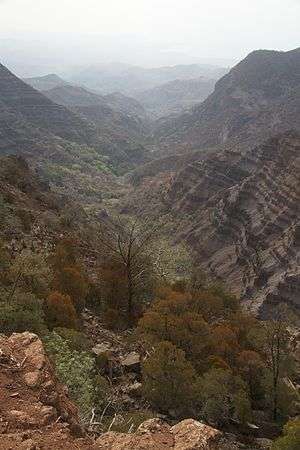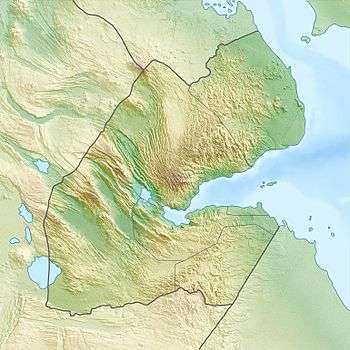Day Forest National Park
Day Forest National Park, also known as Forêt du Day National Park, is a national park in the Goda Mountains and Tadjourah Region of Djibouti.[2]
| Day Forest National Park | |
|---|---|
IUCN category II (national park) | |
 Day Forest National Park in the Goda Mountains. | |
 Location in Djibouti | |
| Location | Tadjourah Region |
| Nearest city | Tadjoura |
| Coordinates | 11°48′N 42°41′E |
| Area | 15 km² |
| Established | 1939[1] |
Flora

Along with Mount Mabla, the Forêt du Day National Park is one of Djibouti's two remnant areas of closed−protected forests.[3] It protects an important forest island in a sea of semi-desert.
It has four dominant tree species: Juniperus procera, Olea africana, Buxus hildebrantii, and Tarchonanthus camphoratus.[4] Doum Palms are found in the western part of the plain of Hanle, at the foot of Gamarré on the edge of the plain of Gagadé. The vegetation becomes more abundant with altitude. Thus the set of Day and its extension to the crest of Goda are occupied by an ancient juniper forest, ficus, mimosa, wild olive trees, boxwood, dragon trees, and other native plants.
This is the largest forest in Djibouti. The forest has a total area of approximately 14500 acres. The most valuable part of national park is 2223 acres large stand of East African junipers Juniperus procera which grows in the heights above 950 m. Junipers here reach height of 20 m, but many trees have died off in recent decades, while the boxwood B. hildebrantii is expanding in their stead.
Fauna
Notable animals found here include the Djibouti spurfowl (Pternistis ochropectus), a population of green-winged pytilia that may actually be a distinct species or subspecies (Pytilia (melba) flavicaudata), as well as the mysterious and undescribed Tôha sunbird—Djibouti sunbird (Chalcomitra sp. indet.). All of these birds do not occur outside of and are endemic to Djibouti, and except for the Francolin they have only ever been found within Day Forest.[5]
More widespread birds inhabiting the forest are Gambaga flycatcher (Muscicapa gambagae), Somali bulbul (Pycnonotus (barbatus) somaliensis) and Somali starling (Onychognathus blythii).[5]
The rare colubrid snake Platyceps afarensis is also found here.
Conservation
The forest as a whole has been under long-term environmental threat. 88% of the Day Forest has been lost over the last 2 centuries, and more than 20% of the loss has occurred during the last 50 years.[6]
References
- WCMC; Areas, IUCN Commission on National Parks and Protected (1992-01-01). Protected Areas of the World: Vol. 3 - Afrotropical: A Review Of National Systems. IUCN. pp. 90–. ISBN 9782831700922. Retrieved 3 November 2012.
- Ham, Anthony; Bainbridge, James (2010-07-30). Lonely Planet Africa. Lonely Planet. pp. 653–. ISBN 9781741049886. Retrieved 3 November 2012.
- "Djibouti - Forestry". Djibouti Wildlife. Archived from the original on 6 October 2013. Retrieved 27 November 2013.
- "BirdLife IBA Factsheet: DJ001 - Forêt de Day", BirdLife International website (accessed 16 May 2010)
- "Archived copy". Archived from the original on 2014-07-05. Retrieved 2014-04-15.CS1 maint: archived copy as title (link)
- "Ethiopian montane forests". Terrestrial Ecoregions. World Wildlife Fund. . accessed 15 January 2009.